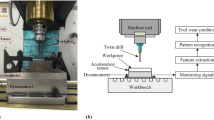Abstract
To avoid the considerable challenges and losses caused by stuck drilling to normal drilling operations, this article analyses the mechanism of stuck drilling, then combines the artificial fish swarm algorithm (AFSA) and support vector machine (SVM), and finally proposes an early warning model for the stuck-in medical drilling process based on the AFSA and SVM. The model realizes real-time sticking risk warnings by using the four parameters of riser pressure, torque, speed and hook load collected in real time and promotes real-time drilling parameter monitoring for the real-time dynamic warning of sticking risk. By comparing the AFSA-SVM sticking prediction model with the particle swarm optimization model and the traditional cross-validation optimization model, it is found that the AFSA-SVM stuck prediction model accuracy can reach 97.561% and that the training and testing times are 5.874 s and 0.76 s, respectively. Its accuracy and computational efficiency are higher than those of the particle swarm optimization model and traditional cross-validation optimization model. In comparison with the existing technology, the four-parameter early sticking warning model based on AFSA-SVM presented in this paper shows powerful comprehensive performance and field application value.










Similar content being viewed by others
References
Jiaqi, Yu.: Analysis of common stuck drill accidents in oil testing and fracturing. Chem Eng Equip. 03, 80–81 (2020). https://doi.org/10.19566/j.cnki.cn35-1285/tq.2020.03.035
Wenjun, Z.: Study on the methods of relieving stuck in oil well workover operations. Chem Eng Design Commun 46(02), 259–260 (2020)
Hao, Su., Yiheng, Q.: Study on the treatment and preventive measures of stuck shale gas drilling. China Pet Chem Stand Qual 39(20), 26–27 (2019)
Annis, M.R., Monaghan, P.H.: Differential pressure stuck-laboratory studies of friction between steel and mud filter cake [J]. J. Petrol. Technol. 14(05), 537–543 (1962)
Hempkins, W.B., Kingsborough, R.H., Lohec, W.E., et al.: Multivariate statistical analysis of stuck drillpipe situations [J]. SPE Dril Eng 2(03), 237–244 (1987)
Biegler, M.W., Kuhn, G.R.: Advances in prediction of stuck pipe using multivariate statistical analysis. IADC/SPE Drilling Conference. OnePetro, 1994
Zhigang, S., Weiguang, S., Juntao, C.: A Study on the Application of Artificial Neural Networks in Real-time Sticking Prediction. Geology and Prospecting. 02, 10–12 (2000)
Wang Yi. Design of an expert system for the diagnosis of stuck drill based on fuzzy theory[D]. Xi'an: Xi'an Shiyou University, 2007: 43–48.
Jian, Hu., Yan, Hu.: neural network-based virtual sample sticking warning device. Oil Field Equipment 40(09), 80–83 (2011)
Vapnik, V.: The Nature of Statistical Learning Theory[M]. Springer-Verlag, New York (1995)
Burges, C.J.C.: A tutorial on support vector machines for pattern recognition[J]. Data Min. Knowl. Disc. 2(2), 121–167 (1998)
Yao Zhenghua. Improved artificial fish school intelligent optimization algorithm and its application research. 2016. China University of Mining and Technology, PhD dissertation.
Weiner, , et al.: Treatment and analysis of complex accidents of AD401–7 directional well stuck. Prosp Eng (Rock and Soil Drilling and Tunneling) 45(04), 10–16 (2018)
Jiming, S., et al.: Treatment of stuck drilling in deep well collapse with complicated trajectory offshore. Oil Drill Technol 38(04), 461–466 (2016). https://doi.org/10.13639/j.odpt.2016.04.011
Gang, Luo, et al.: Sand bridge stuck drilling accident safety evaluation system. Pet Machine 41(05), 7-10+14 (2013)
Fayong, F.: Reverse circulation pressurization treatment method for sand bridge stuck in long horizontal wells. Petroleum Drilling Technology 39(06), 60–62 (2011)
Zhihua, Z.: Machine learning [M]. Tsinghua University Press, Beijing (2016)
Ping Yuan, Zhou Yajian, and Yang Yixian. Research on key technologies of clustering and text classification based on support vector machines. People's Posts and Telecommunications Publishing House.
Li Xiaolei. A new intelligent optimization method-artificial fish swarm algorithm[D]. Zhejiang University, 2003.
Chang, C.-C., Lin, C.-J.: LIBSVM: A library for support vector machines. ACM Trans. Intell. Syst. Technol. (2011). https://doi.org/10.1145/1961189.1961199
Jung, Y.: Multiple predicting K-fold cross-validation for model selection. J Nonparametr Stat (2017). https://doi.org/10.1080/10485252.2017.1404598
Xinshe, Y., Deb, S., Fong, S.: Accelerated particle swarm optimization support vector machine for business optimization and application. Network digital technology. Springer, Berlin Heidelberg (2011)
Juxin, Hu., Gongjie, Z.: Selective ensemble classification algorithm based on K-fold cross-validation[J]. Bullet Sci Technol 29(12), 115–117 (2013)
Qinghua, Wang, Jiangwei, Liu, Lanlan, Zhang: Cross-validation K-nearest neighbor algorithm classification research [J]. J Xi’an Technol Univ 35(02), 119-124+141 (2015)
Author information
Authors and Affiliations
Corresponding author
Additional information
Publisher's Note
Springer Nature remains neutral with regard to jurisdictional claims in published maps and institutional affiliations.
Rights and permissions
About this article
Cite this article
Xian, Z., Yang, H. An early warning model for the stuck-in medical drilling process based on the artificial fish swarm algorithm and SVM. Distrib Parallel Databases 40, 779–796 (2022). https://doi.org/10.1007/s10619-021-07344-z
Accepted:
Published:
Issue Date:
DOI: https://doi.org/10.1007/s10619-021-07344-z




